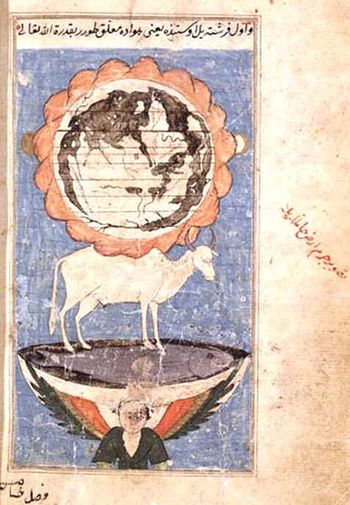カフ山
Mount Qaf, or Qaf-Kuh, also spelled Cafcuh and Kafkuh (テンプレート:Lang-fa), or Jabal Qaf, also spelled Djebel Qaf (アラビア語:جبل ق カフ山(Mount Qaf)、またはカフ・ク(Qaf-KuhあるいはCafcuhあるいはKafkuh、ペルシア語: قافکوه)、またはジャバル・カフ(Jabal QafあるいはDjebel Qaf、アラビア語: Djebel Qaf)、またはコ・イ・カフ(Koh-i-QafあるいはKoh-QafあるいはKuh-i-QafあるいはKuh-e Qaf、ペルシア語: Koh-Qaf)、またはク・イ・カフ(ペルシア語: Kuh-e-Qaf)。جبل قاف)、またはKoh-i-Qaf、Kuh-i-QafまたはKuh-e Qaf( Persian: کوہ قاف)は、中東の俗信にある伝説上の山である。イスラム教の伝統では、カフ山はジンの故郷であり、神によって輝くエメラルドで作られたと言われている[2]。
イランの伝承
歴史上、イランの勢力は北コーカサス全域に及ぶことはなく、古代の言い伝えではこの高山は謎に包まれていた[3]。イランの伝承では、カフ山は以下のような特徴を持っていた。
カフ山のペリの王国とディヴの王国には、壮大な首都ユヘラバード(Juherabad)(宝石都市)を持つShad-u-kam(快楽と喜び)、アンバーラバード(Amberabad)(琥珀都市)、アヘルマナーバード(Ahermanabad)が含まれる[2]。
アラビアの伝承
アラビア語で「カフ山」は、地球を取り囲む海の彼方にあることから「地の果て」と呼ばれる神秘的な山である[5]。その遠さから、北極点はこの山と同じ、とされることもある[6][7]。
According to Hatim Tai’s account, the Qaf Mountains were said
to be composed of green emerald, peridot or chrysolite, whose reflection gave
a greenish tint to the sky. It is regarded as the home of the Jinn race and the place beyond which the unseen divine world begins. In Arabic literature, Qaf was the loftiest of the mountain ranges created by Allah to support the earth and was the parent of all other earthly mountains, to which it was linked by subterranean ranges. The range is separated from the world of men by the oceans that surround the known world. Qaf, as the primeval mountain, came to symbolise the cosmic mountain where the natural and supernatural met and the link between the terrestrial and celestial worlds was established. It is said that the anqa and rukh will come here. The emerald-made cities Jabulqa and Jabulsa, situated in darkness, are said to be contiguous to the mountain Qaf.[2][5][8]
Zakariya al-Qazwini published ʿAjā'ib al-makhlūqāt wa gharā'ib al-mawjūdāt ("The Wonders of Creation", literally "Marvels of things created and miraculous aspects of things existing")[9] in the 13th century, a book that was influential in early modern Islamic society. According to Qazwini's cosmology, the sky is held by God so that it does not fall on Earth. The Earth is considered flat (later Islamic scholars believed that it was round) and surrounded by a series of mountains —including Mount Qaf— that hold it in its place like pegs; the Earth is supported by the Kuyuthan that stands on Bahamut, a giant fish (テンプレート:Lang-ar Bahamūt) dwelling in a cosmic ocean; the ocean is inside a bowl that sits on top of an angel or jinn.[10]
According to certain authors, the Jabal Qaf of Muslim cosmology is a version of Rupes Nigra, a mountain whose ascent —such as Dante's climbing of the Mountain of Purgatory, represents the pilgrim's progress through spiritual states.[11]
Sufi tradition
In some Sufistic oral traditions, as conceived by Abd al-Rahman and Attar, Mount Qaf was considered as a realm of consciousness and the goal of a murid. Hadda Sahib (d. 1903) is said to have visited Mount Qaf in one night and was greeted by the king of peris.[12]
In literature
Mount Qaf (original Turkish title Kafdağı) is also the title of a novel by Turkish author Müge İplikçi.
Mount Qaf is frequently referenced in the 1001 Nights as a home of jinn.
関連項目
Further reading
- Daniel G. Prior: Travels of Mount Qāf: From Legend to 42° 0' N 79° 51' E. in: Oriente Moderno, Nuova serie, Anno 89, Nr. 2. (Studies on Islamic Legends) 2009, pp. 425–444
参考文献
- Wikipedia:Mount Qaf
参照
- ↑ 1203-1283。ペルシア人の法学者、宇宙構造論学者、地理学者。
- ↑ 2.0 2.1 2.2 2.3 https://books.google.com/books?id=qKL3AgAAQBAJ , Legends of the Fire Spirits: Jinn and Genies from Arabia to Zanzibar, Lebling, Robert, I.B.Tauris, isbn:9780857730633, pages24-28
- ↑ كوه قاف در اسطوره و عرفان ايراني , https://web.archive.org/web/20090219041846/http://naghashi.blogfa.com/post-43.aspx , 2009-02-19
- ↑ カフ(Qāf)は、中世ペルシャ語で「不明」を意味する「gâp」がアラビア語化したものである。ガプク(Gapkuh)または未知の山についての最古の記述は、シャプール1世(AD241-272)の黒海とカスピ海の間の山々についての碑文である。コーカサス山脈の名前は、最終的にガプク(Gapkuh)の変種であるKapkofまたはKafkazから来ていると言われている。
- ↑ 5.0 5.1 Mount Qaf - Mythology Dictionary
- ↑ Ibrahim Muhawi & Sharif Kanaana. Speak, Bird, Speak Again: Palestinian Arab Folktales. Berkeley University of California Press
- ↑ Irgam Yigfagna; al-Jabal al-Lamma
- ↑ テンプレート:Cite book
- ↑ The Wonders of Creation - World Digital Library
- ↑ Zakariya al-Qazwini. ʿAjā'ib al-makhlūqāt wa gharā'ib al-mawjūdāt (The Wonders of Creation). Original published in 1553 AD
- ↑ Irgam Yigfagna; al-Jabal al-Lamma, p. 44
- ↑ PRIOR, DANIEL G. “TRAVELS OF MOUNT QĀF: FROM LEGEND TO 42° 0' N 79° 51' E.” Oriente Moderno, vol. 89, no. 2, 2009, pp. 425–444. JSTOR, www.jstor.org/stable/25818227. Accessed 18 Mar. 2020.
